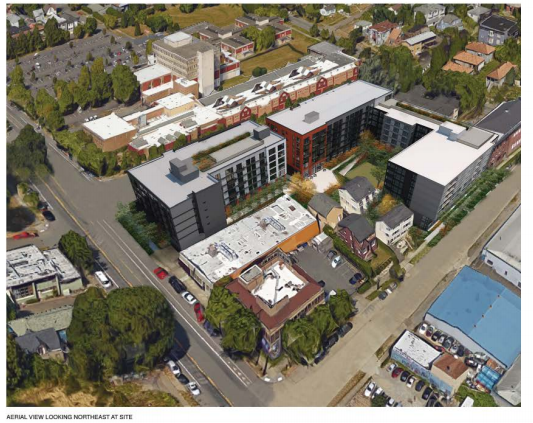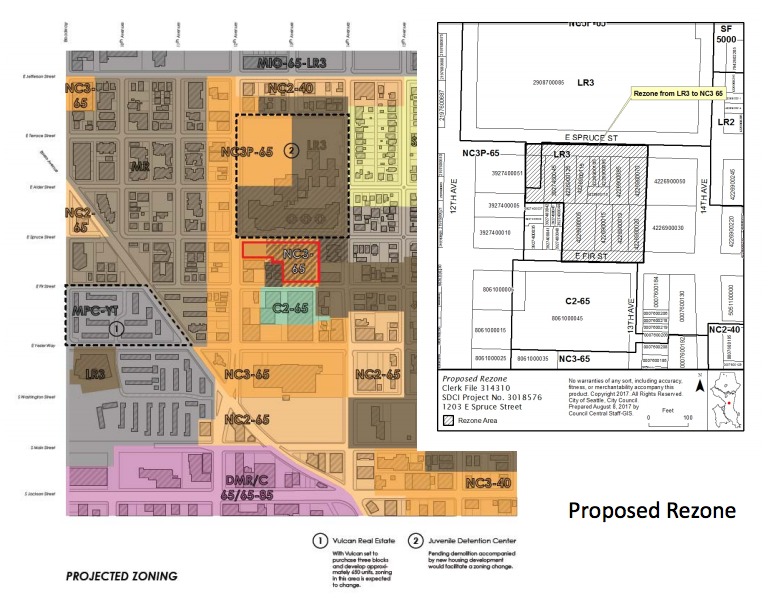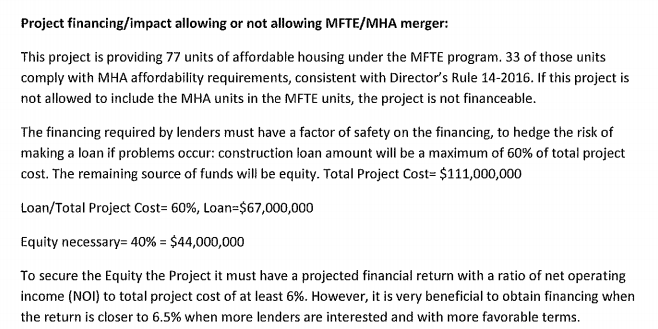On Tuesday, the Seattle City Council voted on legislation to rezone a site across from the King County Juvenile Detention Center on Squire Park. The rezoned site is proposed to become a series of low-rise mixed-used buildings. The City Council also adopted final legislation for vacant building demolition. Both pieces of legislation were approved unanimously. Separately, the City Council modified a resolution related to the Chinatown-International District rezone to formally acknowledge the Filipino community.
Rezone at 1203 E Spruce St
The rezone will allow mixed-use development of a 62,000-square foot site. Zoning on the site will change from Lowrise 3 (LR3) to Neighborhood Commercial 3 with a 65-foot height limit (NC3-65). The proposed development for the site has already received land use and design approval for 369 dwelling units, 18 live-work units, and 9,000 square feet of commercial space. These uses will be spread across three six-story buildings. In between the buildings, the developer will construct a courtyard and provide a mid-block connection through to the street. A total of 310 parking spaces will also be provided on-site.

Since the developer is receiving a rezone, the development will be subject to Mandatory Housing Affordability (MHA) requirements for commercial and residential development. The developer is evaluating how their project may participate in the MHA and Multifamily Tax Exemption (MFTE) programs.
A memorandum by Council Central Staff highlights the challenge that developer–one Capitol Hill Development, LLC–faces in this regard. “The [developer] proposes to provide additional affordable units and apply for a property tax exemption on the residential improvement value of the project pursuant to the [MFTE] Program.” However, the memorandum also states that: “The [developer] has indicated that unless units provided through the MHA Program also count as affordable units for the MFTE Program, the project may not provide a high enough return for a lender to underwrite a construction loan.”

How the developer resolves the issue of financing for the MFTE and MHA units is something to watch. Below is the analysis the developer provided the City.

Vacant Building Demolition Ordinance
Vacant buildings are a widespread issue across Seattle with many of them the result of pending development applications where applicants ended leases for occupancy before building permits are issued for development. Data shows that vacant building complaints have been rising in recent years. Many of the complaints comes from fires, vandalism, and suspicious behavior. To address many of these issues, an ordinance was developed to:
- Strengthen requirements for securing vacant buildings;
- Expedite the process to order removal of junk, garbage, and debris on vacant properties;
- Speed up the process for demolishing hazardous vacant buildings; and
- Reduce the timeframe for demolishing vacant rental housing associated with a redevelopment proposal and expanding the provisions to commercial, industrial, and multi-family residential zones.
The key changes in the ordinance are as follows:
- Strengthening Requirements to Secure Vacant Buildings. The Seattle Housing and Building Maintenance Code (HBMC) requires that property owners manage their properties even when they are vacant. Buildings that are vacant are required to have glazing or plywood covering all windows to protect them against vandalism and entry. Current code only requires nails and materials that are a quarter-inch thick. The adopted ordinance bumps up the requirements to at least half-inch thick materials and use of screws to more tightly secure plywood or glazing. Other materials, such as impact resistance clear polycarbonate sheeting or commercial-quality steel security panels, may be used, too.
- Authority to Remove Junk, Garbage, and Debris. The HBMC is modified to allow the Seattle Department of Construction and Inspections (SDCI) to issue an order or notice of violation to owners of vacant property if there are visible nuisances present like debris, litter and garbage, junk, waste, combustible materials, and overgrown vegetation. The owner would be responsible for removing these nuisances. But if the owner failed to do so, SDCI would have the authority to enter the property abate the nuisances on behalf of the public. The owner will be responsible for all costs associated with property abatement.
- Authority to Remove Hazardous Buildings. The HBMC is modified to allow SDCI to issue an emergency order to remove or demolish any building that has been the subject of two or more documented unauthorized entries in a 12-month period and that presents a danger to the public. SDCI will have to receive documented notice from the Seattle Fire Department or Seattle Police Department.
- Demolition of Residential Buildings. The Seattle Land Use Code controls when demolition permits can be issued for housing units. Currently, if a residential structure is in residential use in a single-family zone and has not been occupied as a rental unit during the previous 12 months, the structure could be removed if it would not result in the expansion of an adjacent non-residential use–such as one on an abutting site. This provision was significantly altered instead conditioning demolition in another way. A residential structure may be demolished if it has not been occupied as a rental unit in the preceding six months and would not help in expanding an adjacent non-residential use in either a single-family or lowrise zone. The sole exception to this would be for the expansion of light rail lines. The effect of this would be to allow demolition of housing units in other zones without the need to first obtain a land use authorization in another, such as a Master Use Permit approval, change of use on a site, or submission of a building permit for another primary use on the site. It will also reduce the waiting period for demolition of housing units after a rental activity has ceased on the site.
The adopted ordinance was modestly adjusted from the one that SDCI presented in 2016.
Filipino Town Recognized
Some readers who followed the Chinatown-International District rezone process may recall that a companion resolution was passed as part of the rezone ordinance. That resolution recognized certain attributes of the district and set expectations for actions to ensure continued livability and vitality of the area. Controversy, however, resulted from the striking of the “Manilatown” acknowledgement in the resolution, which had appeared in earlier language but never made the final cut into the resolution.
In response, the Seattle City Council adopted another resolution to fully acknowledge Filipino community as part of Chinatown-International District. Though the original resolution is only modified to read with one “whereas” recognizing WHEREAS, the area known as Chinatown/International District (C/ID) includes the neighborhoods of “historic Filipino Town”–along with Little Saigon, Japantown, and Chinatown–the resolution adopted yesterday explains the unintentional omission, relationship of past actions by the City recognizing the Filipino community, and how the ethnic precinct came to be:
WHEREAS, the term “Manilatown” was used by Filipino-American “Uncle Bob” Santos, an Asian-Pacific Islander community leader known as the mayor of Seattle’s Chinatown/International District, and many others to show their love for the Chinatown/International District; and
WHEREAS, the Filipino community is an important part of the inclusive and diverse Chinatown-International District neighborhood; and
WHEREAS, The City of Seattle acknowledged the Filipino community’s presence, vibrancy, and contributions in 2011, when it helped fund a 7-foot-tall kiosk under the Only in Seattle grant and proclaimed November 2012 as “Honoring Filipino Americans in Seattle Chinatown ID History Month”; and
WHERAS, “Filipino Town” was the inclusive name used in the U.S. Department of the Interior National Park Service nomination for adding the Seattle Chinatown Historic District to the National Register of Historic Places Inventory; and
The kiosk that the resolution mentions is located at southwest corner of S King St and 6th Ave S and provides some context to local Filipino history.
Stephen is a professional urban planner in Puget Sound with a passion for sustainable, livable, and diverse cities. He is especially interested in how policies, regulations, and programs can promote positive outcomes for communities. With stints in great cities like Bellingham and Cork, Stephen currently lives in Seattle. He primarily covers land use and transportation issues and has been with The Urbanist since 2014.


